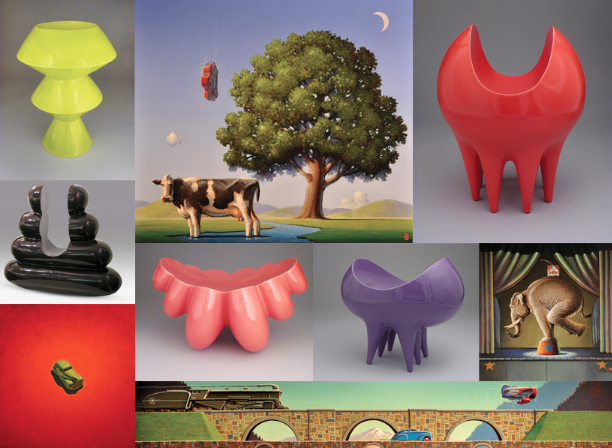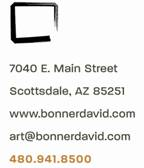
Eric Boos creates and designs artwork made of a unique material, cast porcelain. Painting cars, trees, toys and everyday life objects, Robert LaDuke personalizes his artwork with a sense of humor.
AZFoothills.com caught up with each of these talented artists and found out what inspires them:
Eric Boos
Q. You have studied ceramics throughout your college career in the seventies, what sparked your interest in this type of art?
A. I started back in 1970, at a time when I was an Anthropology undergraduate and the University of California, Santa Cruz. I wandered into the university ceramics studio one day and was fascinated by what the students were doing. I wondered if I, too, could do it. So I signed up for a class and was instantly hooked.
Q. How do you find your inspiration for your pieces?
A. Inspiration is everywhere, and in everything. As an artist, you open yourself up to inspiration. You live in a world in which even the most ordinary things can inspire new ideas.
Q. You currently have an upcoming exhibition in the Bonner David Galleries, would you describe your inspiration for this collection?
A. I had this vision of walking into an ordinary room, and there in the middle of everything would be this glowing, vibrating, colorful object, an object which was unusual, unique, and captivated your attention. I set about making those objects.
Q. Your biography (via Bonner David website) shows you have taught on and off at various institutions, what can you tell us about your experience teaching young artist?
A. Teaching can be great fun. As I see it, I’m not really teaching ceramics, even though that’s what the class is called. Ten years from now, most of my students won’t be doing ceramics. But they probably will be doing something that requires creative thinking, and that’s what I’m trying to teach: that everyone can be genuinely creative and original.
Q. There are many materials an artist can sculpt (bronze, wood), when did you discover porcelain?
A. I’ve known about porcelain since 1970, and worked with it off and on, along with a lot of other types of clay. I simply wanted a very smooth clay to get the refined shapes I was after, and a very white clay, to bring depth and luminosity to my glazes. Porcelain answers those needs, even though it’s very challenging to work with.
Q. How long did it take you to perfect sculpting with a material like porcelain?
A. I wouldn’t claim to have perfected anything. Mostly, I can get the porcelain to do what I want, as long as I’m very, very careful with it. But I also have to be ready for failure at any moment. Porcelain loves to crack, and warp, and the glazes don’t always adhere properly. It can be very frustrating to work with, but spectacular when it does work.
Q. While viewing your personal web page, I noticed that while the title of the piece is “bowl of grapes” you actually place grapes onto the piece, how did you arrive at this concept (using sculptures and real aspects)?
A. I refer to the pieces I make as “bowls,” even though they aren’t normal bowls at all, but rather sculptures with a basin-like area. I like having a reference to something ordinary and useful, like a bowl, and then developing that reference into something outlandish and sculptural. I thought it would be fun to photograph some of my pieces with different fruits and vegetables in them. I like the colors, and it gives the work a sense of scale.
Q. Who has influenced you as an artist and why?
A. I seem to be influenced by both ancient ceramics from around the world, and art/craft/design of the late 20th century and early 21st. I am equally enamored by a Mycenaean Greek funerary urn, the latest Swatch wristwatch, or a sculpture by Anish Kapoor.
Q. You have been an artist for years now, what has been your biggest accomplishment?
A. My biggest accomplishment has been being able to bring pleasure into people’s lives through my art work.
Robert LaDuke:
Q. According to the Bonner David biography, your paintings combine memories, dreams and everyday life. Are these inspired by our own personal life or from what you see around you?
A. Inspired by my own memories and dreams. I paint a lot from toys that I had as a child. I have a collection of old toy steel cars that were my Grandfathers'. I think they are from the 1930's; I like the rounded shapes.
Q. The type of artwork you create is considered epoch narrative, could you enlighten our viewers as to what epoch narrative is?
A. Honestly, I haven't heard that expression before. I like to think of my paintings as open ended narratives. I prefer to have the viewer fill in the blanks with their own story. My paintings usually begin with a small sketch. I draw whatever comes to mind and then build upon it. I don't ever have a complete idea as to what the painting will look like or be about. I find it to be more interesting to let the painting tell me what it is about rather than force an idea. I think this approach is what has kept me interested in painting for so many years.
Q. Given your concept, allowing the viewer to imagine the ending, have you ever found it difficult to not finish the story?
A. I don't think I have an ending for the story. I never think about it, really.
Q. While looking through the Bonner David website, I noticed three paintings (Green, Rain, and Bridge) with classic cars, what is your interest, if any, in classic automobiles and why?
A. I grew up with my Grandfather. He drove a late 1940's Pontiac when I was little. I always loved the rounded streamlined shape of that car. When I think car, I think 1940's. Usually if there is a car in my painting it represents my Grandfather.
Q. Who has influenced you as an artist and why?
A. When I was in high school I stumbled accross a book on Maxfield Parrish. I think I learned more by studying his methods than from any other source.
Q. How long does it typically take you to develop a collection for a future exhibition?
A. I like to paint fairly small pieces most of the time. So, If I have to, I can finish most paintings in about 10 days. I use 10 days as an average to figure out weather or not I can complete the number of paintings that are required for a show.
Q. As an artists, you have traveled from the west to east coast for exhibitions, where has your most memorable exhibition been and why?
A. I don't think I could pick a favorite. Traveling to different cities for me is such a wonderful way to conclude months of hard work and long hours.
Q. The Bonner David Galleries say ‘injects his own distinctive sense of humor’ in regards to our paintings, how would you describe your humor?
A. It's a little on the dark side most of the time. I have a painting in the BD show called "Smoke." It depicts a woman teaching her little dog to catch a ball. In the background her house is on fire. Even though the painting depicts a tragic event I find humor in the fact that the figure in the painting is somewhat oblivious to her surroundings. It's actually how I feel when I am painting. At times I find myself so involved in painting a picture that the world around me disappears.
Q. What has been your biggest/greatest accomplishment throughout the years of being a successful artist?
A. I think the fact that I have been able to survive in this world by creating paintings is my greatest accomplishment. I am fortunate that my favorite thing to do is also the thing that keeps a roof over my head.
Make sure to catch this spectacular exhibit at Bonner David. The special reception is Thursday. December 8, 2011 from 6:00-9:00 PM. The exhibit is available for viewing from December 8-24, 2011.
For more information visit www.bonnerdavid.com. Click here to visit the Bonner David Galleries Blog.

